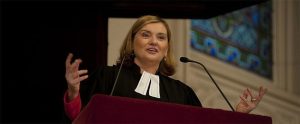From Blois to Ferrara
Renée de France, the daughter of Louis XII and Anne de Bretagne, was born in Blois in 1510.
Ann, an intelligent girl, studied to quite an advanced level for her time. She may have received instruction from Lefèvre d’Etaples, who had come to the court as tutor to the royal children and as the king’s librarian. She was in contact with the humanist circle, which was strongly influenced by Marguerite d’Angoulême, the future queen of Navarre, who became a close friend of hers.
On the 28th of June 1528 she married the inheritor of the duchy of Ferrara, Hercule d’Este : the ceremony took place at the Saint Chapelle in Paris.
Renée’s court in Ferrara attracted some of the most brilliant figures of the Italian Renaissance.
At an early stage, she provided refuge and welcome for those who had taken up the reformed faith.
- She welcomed Clément Marot, who became her secretary in 1535
- In 1536 Calvin, under the name of Charles d’Espeville, also came to her court for three weeks only to leave secretly some time later. After three months he settled in Geneva. It was at this time that the Institution de la religion chrétienne was published. He began to write letters to the duchess of Ferrara and their correspondence lasted for nearly thirty years.
Renée de France never broke away from the Catholic Church – she would not have been in a position to do so anyway – but she was deeply attracted to the reformed religion. It is difficult to ascertain whether an evangelical Church actually existed in Ferrara, but one can make a calculated guess that there were active “religionnaires”, that is to say, people attracted to the new reformed religion at her court in 1550. One of them was the Italian preacher and reformer Bernardo Ochino (1487-1564) who had to take refuge in Switzerland some years later.
Rome did not take kindly to this situation and ordered sanctions to be taken against the duchess : her daughters were sent to a convent and the duke called on the Jesuits of Ferrara to found a college in 1545, where his eldest son Alphonse would be educated later.
The duchess was accused of heresy and had to appear before the Tribunal of the Inquisition.
She was condemned to lifelong imprisonment and all her goods were confiscated. The duke had her imprisoned, but the duchess gave way to the Tribunal, obeying their instructions and taking a more active part in Catholicism from that time onwards. This resulted in her being let free.
From Ferrara to Montargis
When the duke died in October 1558, she was given the right to stay on in the manor house and also own some land, on condition that she lived the life of a good Catholic. However, her son, duc Alphonse II, feared that this might prove difficult for her so he agreed to her leaving Italy and settling in France.
After spending some time at court, she went to live in Montargis in 1560. Indeed, having renounced all rights to her estate in Brittany, she had inherited the manor house of Montargis in compensation.
She commissioned the protestant architect De Cerceau to carry out the necessary alterations and repairs to the house.
It was in Montargis that she led an intellectually stimulating life and her home became a place of welcome for the Protestants. She became friendly with Admiral de Coligny and his wife Charlotte de Laval.
Renée de France's family was deeply affected by the religious wars
The massacre of Wassy on the 1st of March 1562 set off the religious wars. Sadly, it was the duchess of Ferrara’s son-in-law, François de Guise, who had married her daughter Anne in 1546, who had ordered the massacre.
Little by little, the war spread throughout the kingdom. Condé seized Orléans. More and more troops were stationed around Montargis. The duc de Guise seized Blois, Bourges then set siege to Orléans on the 5th of February 1563. Many wounded men took refuge in Montargis, where the duchess gave them medical aid.
The duc de Guise tried in vain to convince his mother-in-law that she should leave her manor house in Montargis and live elsewhere.
When he came back to the siege of Orléans he was mortally wounded by Poltrot de Méré, who had formerly been a conspirator at Amboise.
The duchess of Ferrara maintained contact with the court, where she was present at the time of Henri de Navarre’s wedding. She was even there on the day of the Saint Bartholemew’s massacre, but she was able to leave Paris before danger threatened and she made Montargis into a place of refuge for the Huguenots fleeing the massacres in the provinces and especially those escaping from Orléans.
She died in Montargis on the 15th of June 1575. The duchess had wanted to be buried in the chapel without any elaborate ceremony – these wishes were respected by her daughter Anne, who had married the duc de Nemours after the death of her first husband.
However, her son, duc Alphonse II de Ferrara, ordered a religious ceremony to be celebrated for her by the catholic clergy.



